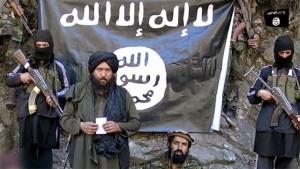 The black flags of ISIL have spread from Iraq and Syria to many other parts of the Islamic world, from North Africa to Central Asia. In recent months they have been seen in Afghanistan, or Khorasan as it is known in Islamic apocalyptic texts – the land where the great armies of conquest shall gather.
The black flags of ISIL have spread from Iraq and Syria to many other parts of the Islamic world, from North Africa to Central Asia. In recent months they have been seen in Afghanistan, or Khorasan as it is known in Islamic apocalyptic texts – the land where the great armies of conquest shall gather.
Mullah Omar’s death brought a dispute over succession, and fissures have revealed themselves between the mullah’s family and his commanders, between moderates and hardliners, between those seeking rule over parts of Afghanistan and those with a more international ideology. Emirate or empire.
ISIL advantages with the Taliban
The Taliban, ever since it took power over twenty years ago, has been divided between those advocating a national agenda of building an Islamic country and those with an international outlook. Oddly, the split manifested itself most prominently over the issue of allowing Osama bin Laden to remain in the country or expelling him to avoid greater hostility from the outside world. Omar is thought to have reluctantly allowed bin Laden to stay as he was a fellow Muslim, if a rather impetuous one.
The US and the Northern Alliance expelled both factions and hunted down bin Laden. Whether the unceremonious departure strengthened either side is unclear. Moderate Taliban leaders argued that the catastrophic foreign invasion showed the folly of the internationalists who harbored al Qaeda, others that it proved the malevolence of the outside world and the need for an international movement.
It is thought that the moderates were overrepresented in Taliban regional commands. Their numbers, however, may have been reduced by American special forces raids and drone strikes. They have been replaced by younger firebrands who are internationalist in outlook.
ISIL’s best asset in establishing itself in Afghanistan may be its record of success which is likely magnified in exhortation and folklore. Taliban fighters have been fighting the Northern Alliance, the US, ISAF, and Afghan troops for twenty years, the last few of which have brought little in the way of impressive gain. Many fighters may see ISIL as a more promising movement, especially now that Mullah Omar is dead.
However, many local and regional commanders may be using ISIL chiefly to oppose the present Taliban leadership, and have no interest in its international agenda.
ISIL disadvantages with the Taliban
Most Taliban fighters are poor rural dwellers with little knowledge of the outside world and little interest in it – except when outsiders intrude upon their district, as the British, Russians, and Americans have done. Nor are they especially religious, at least according to the exacting and unforgiving standards of ISIL. Their understanding of Islam is accented with local practices which ISIL would see as heresy and try to quash.
Further, most ISIL jihadis are reasonably educated urban dwellers who will be as inclined to look down upon the local rustics as the Arab volunteers did during the Russian war. Taliban fighters are war-weary and eager to return to their villages. They do not yearn to reclaim an imperial past or gain martyrdom or thrust the world into apocalypse.
The present Taliban leaders oppose ISIL’s presence. Though talks are on hold as the succession issue flares, the leaders are prepared to negotiate a settlement with Kabul that presumably would grant them control over parts of the country they have conquered. Further, they see ISIL as a rival organization that could break down the unity that’s been won over the years and return Afghanistan to the chaos that followed the Russian withdrawal.
We may see the bewildering though not unwelcome paradox of the Taliban facilitating American drone strikes on wayward commanders. Indeed, such cooperation may already have taken place as over the years more than one independent-minded commander has suddenly met his fate from above.
Jihadis in the east
ISIL will find far better opportunities with the miscellany of jihadi groups ensconced in the mountains straddling the frontier straddling eastern Afghanistan and northwestern Pakistan. The thousand or so fighters intermingling with al Qaeda, Lashkar-i-Taiba, and Jaish-i-Muhammed are international in both personnel and outlook. They include Punjabis, Pashtuns, Uighurs, Azeris, Uzbeks, and Arabs; and they participated in or supported attacks in India, Britain, Indonesia, Spain, and of course the US.
These jihadi groups have ties with Pakistan’s ISI, which views them as reliable if not always controllable assets in its struggle with India in Kashmir and Afghanistan. ISI, however, is backing the moderate faction of the Taliban, pressing them to reach a settlement. This stems from China’s plans to become developer-in-chief of Afghanistan’s appreciable mineral wealth (oil, iron, copper, gems, rare earths) which they have been acquiring rights to over the many years of warfare. Pakistan, for a negotiable fee, will provide the export routes; American and American-trained troops have long been providing the security.
Al Qaeda, Lashkar-i-Taiba, and Jaish-i-Muhammed could be swayed by ISIL’s message and prestige and, perhaps in conjunction with the Pakistani Taliban, pose a serious, protracted problem for both Pakistan and China.
©2015 Brian M Downing